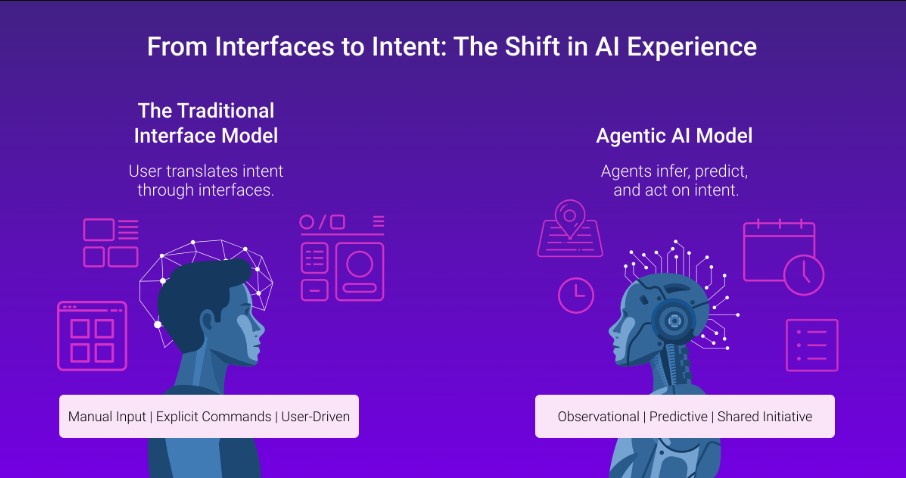For years, digital experience has followed a familiar trajectory: simplify interactions, reduce friction, and design interfaces that help users express what they want in ways machines can understand. From command-line inputs to graphical user interfaces to conversational AI, every advancement has aimed to make the user’s intent more accessible to machines.
But interaction itself has always been a constraint. The system still waits. The user must initiate, define, and instruct. Interaction has served as the bridge between intent and execution; necessary, but increasingly insufficient. As artificial intelligence systems grow more capable of perceiving, reasoning, and acting autonomously, this model is shifting. The starting point for experience is no longer interaction. It is intent itself.
Beyond Interfaces: The Silent Limitation
Interfaces have served their purpose well. They allowed users to navigate complexity and made large systems manageable. Yet even the most sophisticated interface remains a translation layer, a workaround for the machine’s inability to infer purpose on its own.
This limitation has defined much of the last three decades of system design. Every form, dashboard, or menu exists because the system lacks awareness of the user’s objective. The burden of translating need into action has always fallen on the user.
Agentic AI fundamentally changes this dynamic. Intelligent agents observe context, interpret behavioral signals, and anticipate likely objectives. Rather than waiting for explicit requests, these systems act preemptively to resolve intent, shifting portions of initiation from the user to the system itself. This doesn’t eliminate human oversight; it rebalances it. Humans focus on supervision, exceptions, and judgment, while agents handle routine and well-scoped decisions.

Experience Without Interaction
This shift reframes how digital systems operate. The success of a system is no longer determined by how easily a user completes a task, but by how often the task is resolved before it even surfaces.
Consider a claims process where qualified data triggers the initiation automatically, without requiring a policyholder to file paperwork. Procurement systems that continuously monitor inventory, vendor health, and market conditions adjust sourcing strategies in real time. Financial portfolios are proactively rebalanced as market shifts occur, not in response to user commands, but through continuous autonomous monitoring.
The common thread across these examples is the same: the experience moves from being something the user operates to something the system manages. Interaction becomes the exception, not the default.
The Intent Layer: A Structural Evolution
This is not simply a question of improved UX. It represents a deeper shift in enterprise architecture. For years, enterprise systems have been organized into three primary layers: systems of record, systems of engagement, and systems of intelligence. Each layer added new capabilities, but all remained reactive.
Agentic AI introduces a fourth layer: intent resolution. This layer interprets signals, decomposes objectives into actionable subtasks, and orchestrates agents that execute actions across business systems, all while adhering to organizational policies, compliance standards, and ethical boundaries.
According to Gartner, by 2028, one-third of enterprise applications will embed agentic AI, rising from less than 1% today (Gartner, 2023). What once sounded theoretical is rapidly becoming operational reality.
Autonomy Requires Discipline
With autonomy comes complexity. As agents initiate actions, be it approving payments, executing transactions, or enforcing policies, enterprises confront a new class of governance responsibilities.
Effective agentic systems embed governance by design. Every decision must be transparent, traceable, and explainable. Boundaries of authority must be clearly defined. Agents must know where their scope ends and when escalation to human oversight is required.
Autonomy is not the absence of control. It is the application of decision-making within well-calibrated guardrails, ensuring that as systems grow more capable, they remain aligned to organizational priorities and ethical obligations.

Agentic AI Is Not Automation
It’s essential to distinguish agentic AI from traditional automation. Automation executes predefined sequences at speed. Agentic AI operates in environments where objectives shift, data evolves, and priorities must be balanced dynamically. It reasons goals and determines what needs to be done even when the full set of instructions is not provided in advance.
Automation follows instructions. Agentic AI resolves intent.
This distinction will define the next generation of intelligent systems. It moves organizations away from rigid process maps toward adaptive, policy-driven frameworks capable of operating in real-world complexity.
Designing for Intent
The implications of intent-driven systems extend beyond technology. They challenge organizations to rethink how business logic is expressed and how goals are operationalized.
Leaders will need to translate business objectives into policies that agents can execute autonomously, while retaining the necessary transparency for governance. Experience design will no longer center around user flows but around agent behaviors, escalation models, and trust frameworks that ensure systems act consistently and reliably.
The future of experience will not be shaped by more elegant interfaces or more efficient clicks. It will be defined by systems that perceive, interpret, and act upon human intent sometimes before users even recognize the need themselves.
That is the design frontier that is now emerging. The organizations that master this shift will not simply optimize operations; they will redefine the boundaries of digital transformation.







